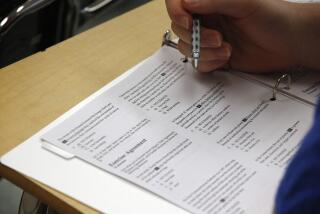CRASH COURSE : Special Review Helps Athletes Learn the Tricks of Taking SAT and Staying Eligible
- Share via
Zan Mason, who usually has no trouble scoring, got only 550 of a possible 1,600 the first time he took the Scholastic Aptitude Test (SAT). Mason, an All-City 4-A player at Westchester High School, was awarded 400 of those 550 points for filling in his name and address correctly.
Knowing that a National Collegiate Athletic Assn. bylaw, commonly known as Proposition 48, would render him ineligible to play college basketball his first year if he didn’t boost his score to at least 700, Mason enrolled in a Princeton Review Course. After only 15 tutorial hours, Mason scored 910. He will play for UCLA this year.
Proposition 48 stipulates that a freshman is ineligible for sports competition and practice at Division I schools if his or her college board tests and high school grades in a core of 11 academic subjects fall below a specified minimum. The standard is a 700 SAT score with a 2.0 grade-point average. Those with lower GPAs must score higher than 700 or conversely, those with better GPAs can score lower without penalty.
An athlete ruled ineligible can retain a scholarship, but will lose one year of eligibility.
Keith Siscel, an All-American lineman at Vacaville High School in 1988, scored 580 the first time he took the SAT and below 700 on four other occasions. He enrolled in a review course. Six weeks later, he had a score of 730 and a letter inviting him to play football at USC, which had denied him admission a year earlier because of his low scores.
Gidion Murrell, an All-American lineman at Palm Springs High School last season, scored 640 and 670 the first two times he took the SAT. His mother says he didn’t have time to enroll in a review course because of college recruiting.
The evening before taking the SAT for the last time, Murrell called Kevin Drexel, executive director of the Princeton course in Beverly Hills. They spoke for half an hour with Murrell taking notes on a scrap of paper he found by the phone. The next day, Murrell scored 700. He will play football at USC this fall.
The Princeton Review Course has no link to the university in New Jersey, although it was founded by Princeton graduate John Katzman. And it did produce improved SAT scores, but aside from test-taking tricks, what did these student-athletes learn ?
“You give me anything other than a corpse, and I can coach them to at least a 700,” Drexel said. “It’s kind of ironic. We didn’t teach them any academic skills. We taught them test-taking skills applicable only to the SAT. These kids really aren’t any smarter.”
Thanks to scholarships provided by shoe manufacturers and other sports-related sponsors, the athletes did not have to pay for the class. And, in terms of accumulated intelligence at least, they say they have gotten their money’s worth.
“I learned the little tricks,” Mason said. “I didn’t gain any knowledge, except for how to take the test. . . . This doesn’t make you a better student. It just helps you take this test.”
What sort of regimen did Mason go through to improve his score by 360 points?
“Oh, it was like a school day,” said Mason, a 6-foot-6 forward. “We worked really hard on the--damn, what do you call them?--the things where you compare four words.”
Mason was referring to analogies, one of the primary exercises in the SAT’s 800-point vocabulary section.
Drexel said, for example, that 40% of the questions in the reading comprehension section can be answered correctly without even reading the corresponding passage--without, in essence, reading or comprehending.
Said Siscel: “They just showed me little tricks and shortcuts--no, not shortcuts, but things to get through them. I didn’t feel any smarter, I just felt a relief after I passed it.”
Douglas S. Hobbs, faculty athletic representative at UCLA and chairman of the National Collegiate Athletic Assn.’s Academic Requirements Committee, said: “Someone who scores that low, I’m not sure is in a position to say he or she isn’t learning anything.”
Drexel, however, admits it unabashedly, saying that he is teaching students only how to take the SAT. Rather than teach pupils vocabulary words and geometric principles, the focus of the course, which has more than 40 branches nationwide, is to show them where not to answer, where to guess aggressively and where to avoid potential SAT traps.
“Some students, especially those with the lowest scores, answer too many questions,” instructor Tom Han said. “We tell them that they need to leave more blank.”
The course also shows students a fool-proof way of determining which sections are experimental and won’t be counted against their scores. A student can then leave the experimental sections blank, without penalty, and, although it is prohibited, go back to work on another section. The course doesn’t encourage students to do this, Drexel said, but it doesn’t discourage it either.
An article in the New Republic last April called the Review a “cram scam” and although it condemned the principle ethically, it couldn’t criticize the results. The Review claims to raise scores by an average of 150 points.
The Educational Testing Service, creator of the SAT, has claimed for years that the test can’t be coached, but has changed its stance in recent years because independent studies have shown that the course can raise scores by an average of 110 points. And Katzman, the millionaire founder of the Review, says increases of only 50 points are rare.
All of which brings Prop. 48 under closer scrutiny. “I am perfectly willing to admit that we are circumventing Prop. 48,” Drexel said.
If a student gets 400 signature points and could earn 110 more through coaching, then that student would only need to answer 15 to 21 of the remaining 145 questions correctly, depending on the test, to reach 700, if he leaves enough blank.
“I’m sure that this is not what the members had in mind when they put in Prop. 48,” said Jim Marcioni, director of communication for the NCAA.
Others qualified to speak on behalf of the NCAA are reluctant to do so. Members of the 10-person NCAA Academic Requirements Committee, for example, say they would rather not comment extensively until an in-house investigation of Prop. 48 is completed at the end of this year. (The first students to enter school since the implementation of Prop. 48 are in their fifth year.)
However, the strong consideration recently of Prop. 42, which would refuse scholarships to athletes who fail to meet its requirements, suggests the NCAA may not be satisfied with the SAT as an accurate predictor of collegiate success. Along with grade-point average, SAT scores are the only variables Prop. 48 uses to determine eligibility.
“If you can learn as much in two weeks as you’ve learned in 12 years of schooling, I say that is pretty strong evidence that the SAT is weak and imperfect,” said Bob Biller, the dean of admissions at USC. “To outlaw such (SAT) classes would be silly. A better thing to do is to stop placing dependence on the SAT.”
Most administrators admit that the SAT is an inaccurate predictor of a student’s ability to succeed in college, but they are nonetheless using it because researching every student completely is too time-consuming and expensive.
The SAT, they say, may be imperfect, it may be culturally biased and it may be unfair to poor test-takers.
“But I don’t know that we are interested in anyone that’s so poor a test-taker so as to score under 700,” says Veda Veach, UCLA’s assistant director of admissions.
The SAT, they say, may be all those things, but they have few alternatives. There are no other ways to verify the strength of a grade-point average without great expense. And as long as that is the case, courses such as the Review will flourish.
More to Read
Get our high school sports newsletter
Prep Rally is devoted to the SoCal high school sports experience, bringing you scores, stories and a behind-the-scenes look at what makes prep sports so popular.
You may occasionally receive promotional content from the Los Angeles Times.






